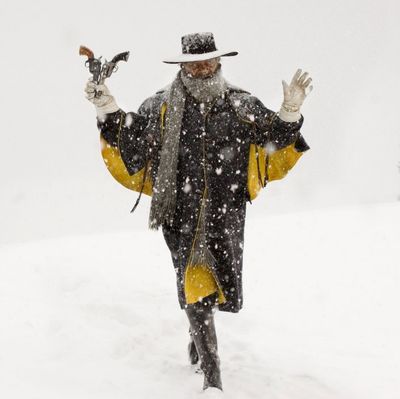
The unpleasant truth exposed by The Hateful Eight is that Quentin Tarantino’s wit and craftsmanship — his artistic soul — are inextricable from his sadism. He has gone to elaborate lengths to make the movie look like a classic widescreen Western, in 70mm, with a thunderously lyrical overture by the great Ennio Morricone and an intermission, but there’s nothing widescreen about his story. It seems perversely crabbed, nihilistic, and shot through with cruelty for cruelty’s sake. I suppose there are precedents among spaghetti Westerns of the ’60s (like The Great Silence), but Italians are stoic about their violence, whereas Tarantino seems to be whacking off to his own mayhem.
As usual, his foreplay is brilliant. Hell, most of what he does is brilliant. Samuel Jackson is bounty hunter Marquis Warren, who gets caught in a blizzard en route to Red Rock and begs a ride in a stagecoach with another hunter, John Ruth (Kurt Russell), and his prisoner, Daisy (Jennifer Jason Leigh). Russell’s John Wayne affect is promptly dispelled when he whomps Daisy (who already has two black eyes) across the face, breaking her nose. A short time later, her jaw is fractured. But still she mouths off, showing a macabre, broken grin, wearing her battered face as a badge of honor, crowing like a Shakespearean witch. What a performance!
The movie proper begins when the occupants of the coach take shelter at a place called Minnie’s Haberdashery — only Minnie and her crew aren’t around, replaced by, among others, Demián Bichir as a scarily furtive Mexican, Tim Roth as a scarily furtive Englishman, and Michael Madsen as a scarily furtive mama’s boy. Apparently, at least. Walton Goggins plays a man who says he’s Red Rock’s next sheriff: not likely. Bruce Dern is a curiously morose ex-Confederate general. The feel is uneasy, pregnant. As Tarantino takes the measure of the space (via Robert Richardson’s breathtakingly sharp cinematography, which captures the grain on the overhead beams), the men take the measure of one another.
Beat by beat, Tarantino teases you with the idea that violence can erupt any second, and the non-action goes on and on, to the edge of the intermission. Damn, the man is good at winding around the central conflict. Jackson’s Marquis becomes a sort of detective, a frontier Poirot or Charlie Chan, registering tiny details (a jellybean on the floor, bad coffee but good stew) while enduring Tarantino’s patented promiscuous use of the N-word. But this is, after all, a short time after the Civil War, the era that goes by the misnomer “Reconstruction,” when bands of Confederates transformed themselves easily, sometimes gratefully, into murderous outlaws, righteous in their barbarity. As in Django Unchained, Tarantino makes you itch for the black man to let slip own his dogs of war.
But when the violence comes, it’s more graphic and nausea-inducing than even a hardened Tarantino viewer could have reason to expect. In an extended flashback, Tarantino crosses into Rob Zombie snuff territory, a description he might well regard as a badge of honor (the bastard) but one I see as emblematic of his descent into a kind of shock-jock territory that dishonors his early work. Consider his last one-set bloodbath, Reservoir Dogs, nowhere near as accomplished a piece of moviemaking but full of psychological cross-currents and emotional quandaries. Tarantino has left emotional quandaries behind. He’s in the grindhouse revenge ether now, high on his own silly, can-you-top-this gross-out carnage. You wonder what he has up his sleeve in The Hateful Eight, but gorgeous as that sleeve might be, what’s up it is crap. The movie is a lot of gore over a lot of nothing. I hope that won’t be Tarantino’s epitaph.
*A version of this article appears in the December 28, 2015 issue of New York Magazine.


